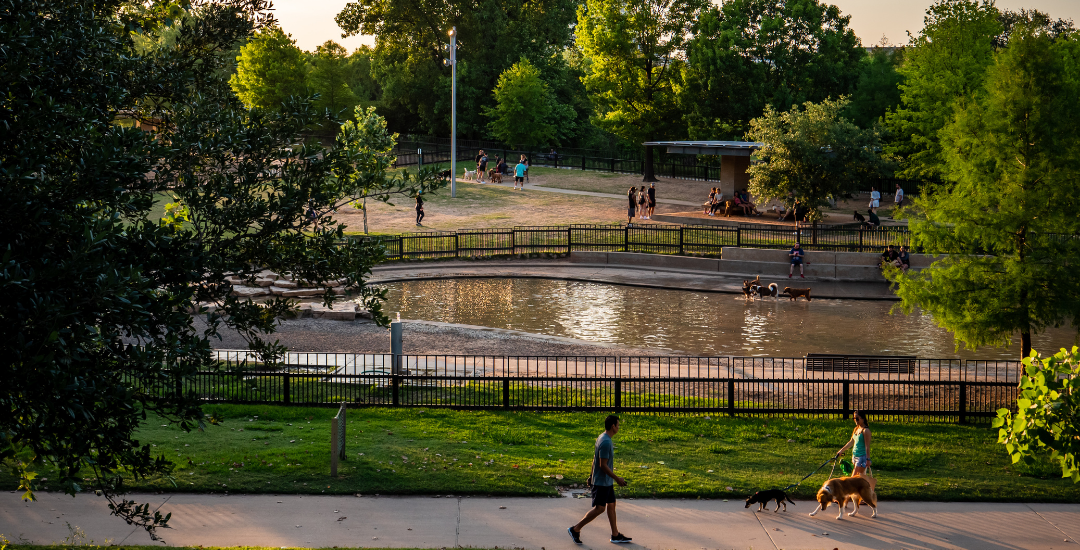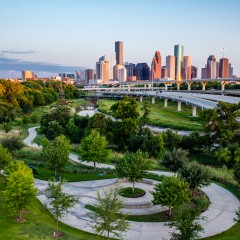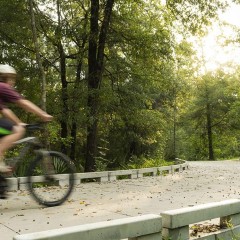The Trust for Public Land (TPL), a national environmental nonprofit that advocates for parks and greenspace, ranked Houston 71st out of 100 major U.S. cities in 2023, citing its below-average investment, amenities and equitable distribution of parks. This aligns with the Kinder Institute’s analysis of TPL data for “Funding Houston's Parks and Greenspace,” which showed that Dallas, San Antonio and Austin each have more parks funding per resident than Houston. It also found that about 1 in 4 Houstonians do not have parks or greenspace within a 5- to 7-minute walk of where they live.
This is a serious problem because parks, beyond their recreational uses, have so many broad positive impacts on their communities. They bolster physical and mental health, reduce flooding and extreme heat, boost local economies and make communities safer. Above all, they form the backbone of strong communities and increase people’s quality of life from youth to old age.
Parks as a public health good
According to the TPL, parks are a type of “social infrastructure,” generally publicly owned and accessible places that are set aside for recreation and enjoyment, and offer opportunities for contact with nature. They are also inherently social spaces, with many featuring sports facilities, playgrounds and community centers. As a result, parks have a positive impact on both physical and mental health.
The physical health benefits are probably the most apparent. Ideally, parks provide a safe, accessible avenue for people to exercise. Living near a park creates a virtuous cycle of greater amounts of exercise and thus better overall physical health, such as better sleep, cognition and cardiovascular health.
A study last year focused on Bayou Greenways, an initiative led by the Houston Parks Board to create 150 miles of public trails and greenspace, found that ZIP codes with greater access (i.e., being within a 10-minute walk or less) had fewer hospitalizations for conditions like obesity, coronary heart disease and heart attacks.
Parks also have been found to provide a host of mental health benefits. The vivacity of green spaces is not just aesthetically pleasing — it has been shown to reduce stress levels. Greater access to parks during the pandemic was “associated with decreased prevalence of depression and anxiety” among urban residents. Park access was even found to improve the mental well-being of parents and their children and strengthen their bond, as well as foster a child’s independence.
That last point is worth dwelling on, as so much of a park’s mental health benefits are related to how they are “third places,” defined by the sociologist Ray Oldenburg as spaces separate from home and work where people can mingle and build relationships, which are essential to a person’s well-being. People with strong social relationships are linked to a 50% lower mortality rate than those without them. More parks can be a panacea for a country in the midst of a loneliness epidemic, and research has shown that more greenspace can lead to people feeling more connected to their neighborhoods.
Parks protect the environment, fight climate change
Parks aren’t just good for humans, though. They are vital for the lives of other species. Parks are sites of wildlife conservation, providing a home for a variety of creatures and preventing biodiversity loss. For example, urban parks can be a stopover for migrating birds and can actually lead to greater genetic diversity among them, making these species more resilient. All the trees in parks also serve as urban lungs, filtering pollution out of the air and capturing carbon from the atmosphere.
Parks and green spaces are crucial to any city’s fight against the effects of climate change and extreme weather, and Houston, at the front lines of a variety of climate and environmental crises, can use all the help it can get.
For one, all that greenery also serves a crucial function during storms by acting as a natural drainage system, absorbing water that would otherwise be flooding roads, homes and businesses. As Houston Public Media reported last year, a great example of this is Exploration Green in the Clear Lake area, which can hold up to half a billion gallons of water, enough to save an estimated 2,000 homes from flooding.
Houston is also no stranger to extreme heat, and this past summer was the hottest on record. Houston particularly suffers as one of the worst cities in the U.S. for urban heat islands, with only 18% of the city covered in tree canopy in 2021, most of which is located on private property. Parks help with that, not only providing cool public spaces but also cooling down their surrounding environment, as several studies out of China have found. The discrepancy in urban heat island effects between the Sharpstown and River Oaks neighborhoods, for example, may partly be attributed to the proximity of those areas to parks.
Parks boost the local economy, make communities safer
All of their health and environmental benefits make parks attractive places to be and encourage people and businesses to locate near parks, boosting the local economy. The National Recreation and Park Association found that in 2019 alone, local park and recreation agencies in the U.S. generated almost $218 billion and supported almost 1.3 million jobs from their operations and capital spending alone. Parks notably have been found to increase property values of nearby communities, which in turn leads to greater property tax revenue for cities. Parks can also increase local tourism, with Houston’s Hermann Park as a key case in point, featuring a golf course, zoo, gardens and proximity to museums and being a site for local festivals and special events. Above all, thanks to the aforementioned health and environmental benefits, parks can reduce medical costs and costs associated with natural hazards like flooding.
Contrary to popular perception that they are gathering spots for illicit activity, there is also evidence that parks and greenspace can reduce crime and increase public safety, which is the top concern of Houstonians. A study found that, on average, areas with more greenspace had lower rates of both property and violent crimes. The reasons include contact with nature lowering stress and aggression, parks fostering positive social interactions that build community, and that community feeling ownership of the space and maintaining an “eyes on the streets” vigilance.
The quality and quantity of Houston’s parks have improved overall in recent years, from big projects like Bayou Greenways to the renovation of Hermann Park and the opening of new parks like Discovery Green. However, as the Kinder Institute’s recent study on parks financing found, they are not equitably distributed throughout the city, let alone adequately funded compared to Houston’s peer cities across the nation. The evidence is clear, though — parks provide crucial health, environmental and economic benefits to their cities and communities. More and better parks would thus mean better lives for all Houstonians, both those already here and those who have yet to arrive.




